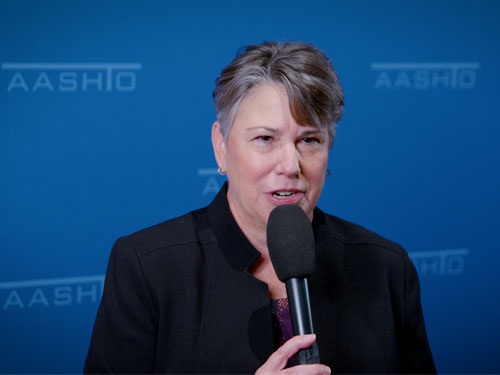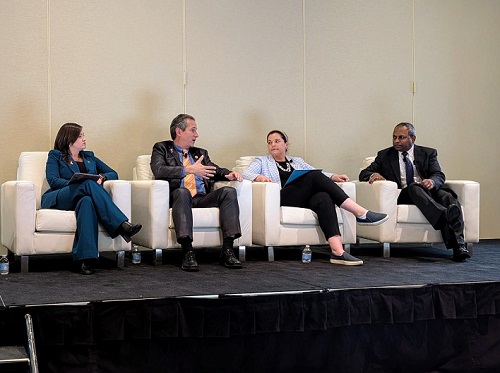A knowledge session at the 2024 American Association of State Highway and Transportation Officials Annual Meeting in Philadelphia explored the latest aviation innovations and trends affecting state departments of transportation – especially in regards to Uncrewed Aerial Systems (UAS), more commonly called drones, and Advanced Air Mobility (AAM) endeavors.
[Above photo by AASHTO]
Sponsored by AECOM, the session entitled “Innovations in Aviation: Trends & Integration with State DOTs” featured several state aviation leaders: Eileen Vélez-Vega, secretary of the Puerto Rico Department of Transportation and Public Works or DTOP; Becca Gallas, director of aviation for the North Carolina Department of Transportation; Tony McCloskey, director of the bureau of aviation for the Pennsylvania Department of Transportation; and Clement Solomon, director of intermodal for the Georgia Department of Transportation.

Vélez Vega – who also serves as chair of the AASHTO Council on Aviation Transportation – noted that, even though DTOP is still in the “studying and planning phases” of what role AAM could play in her territory’s current aviation system, there is a lot of opportunity.
“It is particularly critical with what we do in Puerto Rico in connection with the rest of the islands of the Caribbean and how we can improve inner island connections,” she explained.
In terms of both drones and AAM, “there are roles for emergency response and tourism, as well as for monitoring for traffic congestion, [infrastructure] inspections, and things like that,” Vélez-Vega said. “And it is also about how we partner with airports plus other partners and stakeholders on using them in other areas of our DOT operations. So I see them as very intermodal, offering interconnected service.”
Georgia DOT’s Solomon made similar observations about the wider role AAM could play within the overall transportation networks managed by state DOTs.
“AAM can form a big part of our everyday life,” he stressed. “Public service agencies can use it for emergency response, for firefighting or to transport food to remote areas. So there’s a much broader context to this.”
Solomon added that while building electric vertical take-off and landing or “eVTOL” aircraft for use in AAM systems is relatively easy, “there are so many other components to consider; infrastructure, communication, and energy supply. All of that needs to be thought through. So I think an integrated federal, state, and local plan would be a really good way to approach this.”

NCDOT’s Gallas said such “integrated planning” when it comes to AAM is crucial in terms of maximizing its potential for communities large and small, urban and rural.
“When we start thinking about the reasons why states are interested in AAM, the [low] noise profile particularly is a big interest to states,” she said.
“Right now, airports – particularly airports in urban areas – are seeing a lot of development pressures and issues with coexisting in dense urban environments. And [noise] is potentially addressed by AAM via electric motors, which have quieter noise profiles,” Gallas added. “So you can start to think about aviation outside of the footprint of an airport. So taking an air taxi from an airport to a downtown area; landing in an urban area with minimal noise impacts.”
The other “incredible thing” Gallas highlighted about AAM is potentially far lower operating cost for all kinds of air services.
“Now it’s important to note that these [air taxi] vehicles are not yet certified, though they should be certified within the next year to two years,” she stressed. “But the operating cost on paper is supposed to be about 1/10th of the cost of a traditional aircraft. So that is an incredible cost savings.”
And that level of savings could open up areas where aviation services were formerly too expensive to contemplate, Gallas stressed.
“When you look at [AAM] infrastructure needs in our coastal areas, for instance, it starts to suddenly become viable to start to look at it as public transportation, or moving patients, or just thinking about aviation in ways that we’ve never been able to imagine before in those communities,” she said.
PennDOT’s McCloskey, who said his agency is currently conducting an AAM feasibility study that should be finished sometime in mid-2025, emphasized the cargo delivery potential AAM offers – especially in terms of speeding up cargo deliveries to more remote areas of the country.
“We are assessing seven business use cases, but I think that the top one out of the gate for Pennsylvania is cargo freight,” he said. “Think about ordering something from Amazon that you need by tomorrow. In some of the rural areas in Pennsylvania, you’re going to get that in four or five days, or maybe 10 days. So there’s a gap. And that’s a gap that this [AAM] technology will fulfill for sure to meet the expectations of our citizens.”
 Top Stories
Top Stories
USDOT Makes $1.5B Worth of BUILD Grants Available
December 19, 2025 Top Stories
Top Stories

